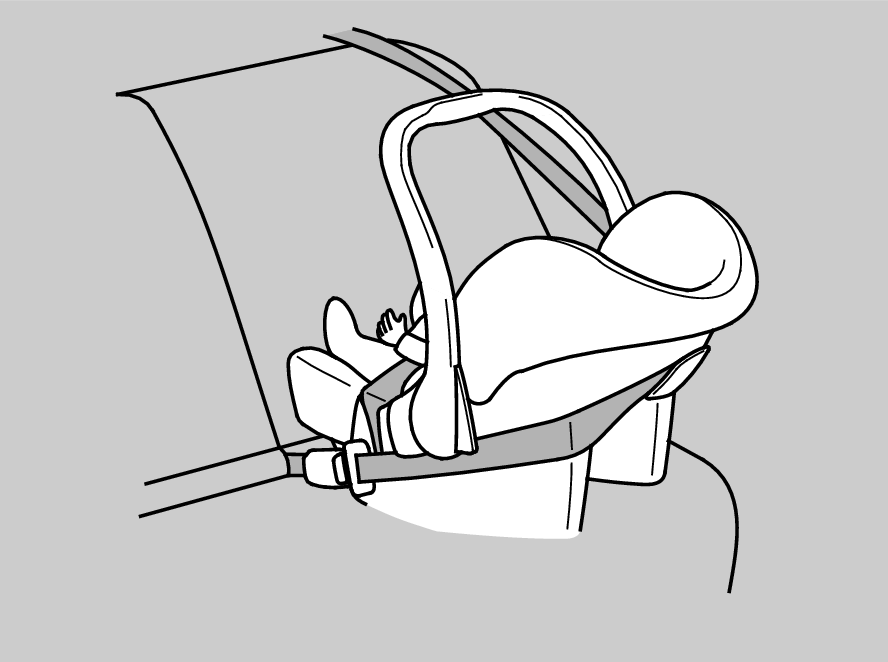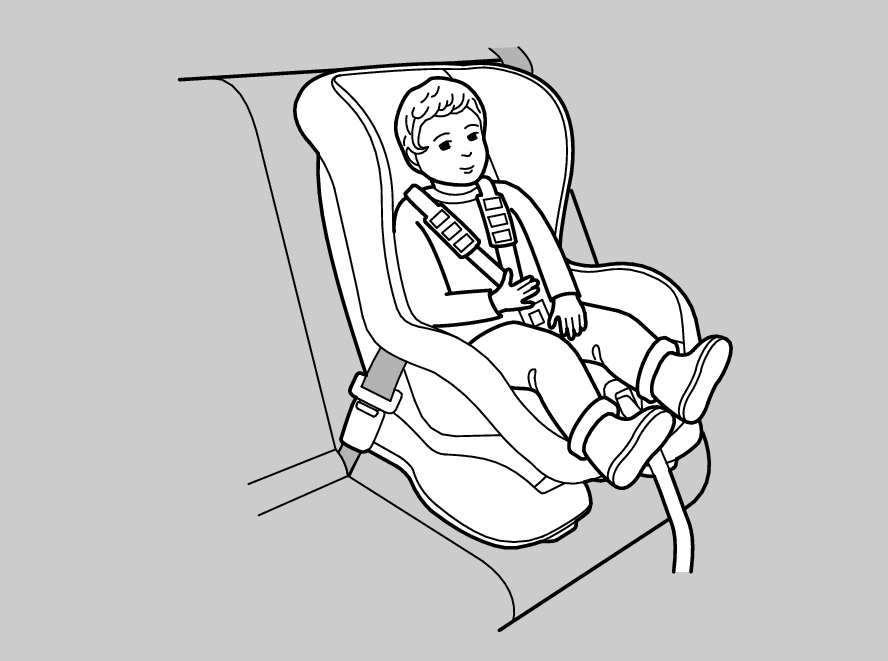Safety of Infants and Small Children
Protecting Infants
An infant must be properly restrained in a rear-facing, reclining child restraint system until the infant reaches the restraint system maker's weight or height limit for the seat, and the infant is at least one year old.
When properly installed, a rear-facing child restraint system may prevent the driver or a front passenger from moving their seat all the way back, or from locking their seat-back in the desired position.
- WARNING
- Placing a rear-facing child restraint system in the front seat can result in serious injury or death if the passenger’s front airbag inflates.
Always place a rear-facing child restraint system in the back seat, not the front.
- WARNING
-
NEVER use a rearward facing child restraint on a seat protected by an ACTIVE AIRBAG in front of it, DEATH or SERIOUS INJURY to the CHILD can occur.
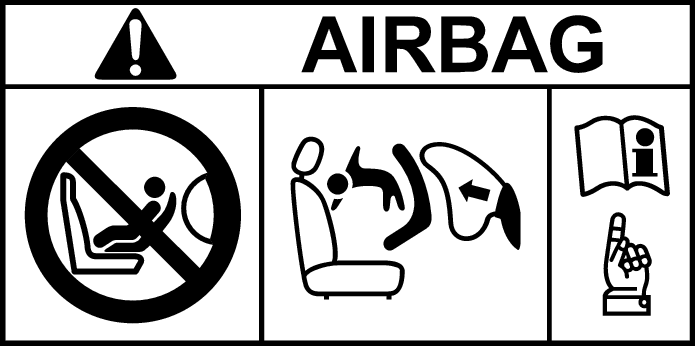
- WARNING
-
Do not use a rearward facing child restraint on a seat protected by an airbag in front of it.
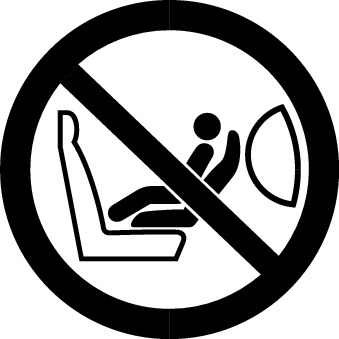
DEATH OR SERIOUS INJURY can occur.
- Detail
-
As required by UN-ECE R94 Regulation:For some typesIf the passenger’s front airbag inflates, it can hit the rear-facing child restraint system with great force, which can dislodge or strike the system, and seriously injure the child.Rear-facing child restraint systems should never be installed in a front facing position.Always refer to the child restraint system manufacturer’s instructions before installation.
Protecting Smaller Children
If a child is at least one year old and within the weight range indicated by the child restraint system manufacturer, the child should be properly restrained in a firmly secured front facing child restraint system.
Placing a front facing child restraint system in the front seat can be hazardous. A rear seat is the safest place for a child.
- WARNING
- Placing a front facing child restraint system in the front seat can result in serious injury or death if the front airbag inflates.
If you must place a front facing child restraint system in front, move the vehicle seat as far back as possible, and properly restrain the child.
- Detail
-
Educate yourself about the laws and regulations regarding child restraint system use where you are driving, and follow the child restraint system manufacturer's instructions.Many experts recommend use of a rear-facing child restraint system for a child up to two years old, if the child’s height and weight are appropriate for a rear-facing child restraint system.
Selecting a Child Restraint System
Some child restraint systems are lower anchorage* compatible. Some have a rigid-type connector while others have a flexible-type connector. Both are equally easy to use. Some existing and previously owned child restraint systems can only be installed using the seat belt. Whichever type your choose, follow the child restraint system manufacturer’s use and care instructions as well as the instructions in this manual. Proper installation is key to maximizing your child’s safety.
The flexible type may not be available in your country.
In seating positions and vehicles not equipped with lower anchorages, install a child restraint system using the seat belt and a top tether for added security. This is because all child restraint systems must be secured with a lap belt or the lap part of a lap/shoulder belt when not using the lower anchorage* system. In addition, the child restraint system manufacturer may advise that a seat belt be used to attach an ISO FIX restraint system once a child reaches a specified weight. Please read the child restraint system owner’s manual for proper installation instructions.
- Detail
-
Installation of a lower anchorage*-compatible child restraint system is simple.Lower anchorage*-compatible child restraint systems have been developed to simplify the installation process and reduce the likelihood of injuries caused by incorrect installation.We recommend to use the genuine rear-facing Honda BABYSAFE ISOFIX child restraint system for infants, and the genuine front facing Honda ISOFIX child restraint system for small children.
Both are available at a dealer in some countries.
Important consideration when selecting a child restraint system
Make sure the child restraint system meets the following three requirements:
- The child restraint system is the correct type and size for the child.
- The child restraint system is the correct type for the seating position.
- Child restraint system is compliant with safety standard. We recommend the child restraint system with the UN-ECE R44 or the regulations of the subject countries. Look for the approval mark on the system and the manufacturer’s statement of compliance on the box.
The Recommended Child Restraint System for Malaysia
Various types of child restraint systems are available. Not all types are suitable for your vehicle. Please refer to the table below to select which category of child restraint system can be used on each seating position.
|
Mass group
|
Seating position
|
|||
|---|---|---|---|---|
|
Front passenger
|
Rear passenger
|
|||
|
Rear Left/Right side
|
Rear centre
|
|||
|
group 0
|
Up to 10 kg
|
X
|
U
|
U
|
|
group 0+
|
Up to 13 kg
|
X
|
U or IL (Honda BABY SAFE ISOFIX)
|
U
|
|
group I
|
9 kg to 18 kg
|
UF*1,*2
|
U or IUF (Size class A, B1, B)
|
U
|
|
group II
|
15 kg to 25 kg
|
UF*1,*2
|
U
|
U
|
|
group III
|
22 kg to 36 kg
|
UF*1,*2
|
U
|
U
|
|
U:
|
Suitable for “universal” category restraints approved for use in this mass group.
|
|
UF:
|
Suitable for front facing “universal” category restraints approved for use in this mass group.
|
|
IL:
|
Suitable for particular ISOFIX child restraint systems (CRS) given in this list.
|
|
IUF:
|
Suitable for front facing ISOFIX child restraint system of universal category approved for use in this mass group.
|
|
X:
|
Seat position not suitable for children in this mass group.
|
|
*1:
|
Adjust the seat-back angle to the most upright position (front most lock position).
|
|
*2:
|
Move the front seat to its rearmost position.
|
A size class is specified for some child restraint systems. Make sure to check the size class as indicated on the manufacturer’s instructions, package, and labels of the child restraint.
The particular child restraints in the table are Honda Genuine Parts. They are available from your dealer.
For a correct installation, please refer to the Child Restraint Instruction Manual.
The Recommended Child Restraint System for India
Various types of child restraint systems are available. Not all types are suitable for your vehicle. Please refer to the table below to select which category of child restraint system can be used on each seating position.
|
Mass group
|
Seating position
|
|||
|---|---|---|---|---|
|
Front passenger
|
Rear passenger
|
|||
|
Rear Left/Right side
|
Rear centre
|
|||
|
group 0
|
Up to 10 kg
|
X
|
U
|
X
|
|
group 0+
|
Up to 13 kg
|
X
|
U
|
X
|
|
group I
|
9 kg to 18 kg
|
UF*1
|
U
|
X
|
|
group II
|
15 kg to 25 kg
|
UF*1
|
U
|
X
|
|
group III
|
22 kg to 36 kg
|
UF*1
|
U
|
X
|
|
U:
|
Suitable for “universal” category restraints approved for use in this mass group.
|
|
UF:
|
Suitable for front facing “universal” category restraints approved for use in this mass group.
|
|
X:
|
Seat position not suitable for children in this mass group.
|
|
*1:
|
Adjust the seat-back angle to the upright position (front most lock position).
|
A size class is specified for some child restraint systems. Make sure to check the size class as indicated on the manufacturer’s instructions, package, and labels of the child restraint.
For a correct installation, please refer to the Child Restraint Instruction Manual.
Installing a Lower Anchorage-Compatible Child Restraint System*
A lower anchorage-compatible child restraint system can be installed in either of the two rear outer seats. A child restraint system is attached to the lower anchorages with either the rigid or flexible type of connectors.
-
- Locate the lower anchorages under the marks.
- Make sure to lock the seat-back in the upright position.
- Lower the head restraint to its lowest position.
-
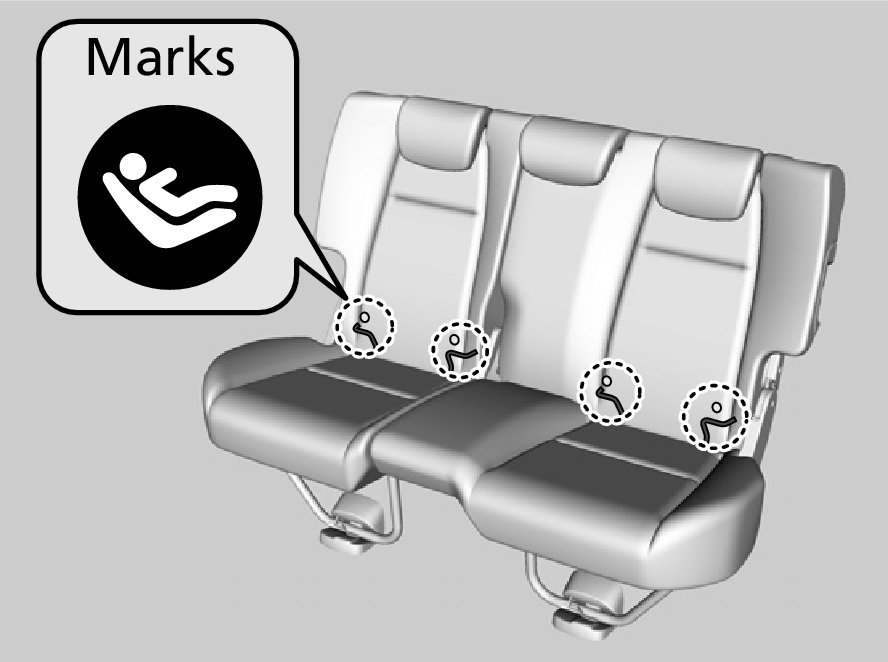
-
- Place the child restraint system on the vehicle seat then attach the child restraint system to the lower anchorages according to the instructions that came with the child restraint system.
- When installing the child restraint system, make sure that the lower anchorages are not obstructed by the seat belt or any other object.
- Place the child restraint system on the vehicle seat then attach the child restraint system to the lower anchorages according to the instructions that came with the child restraint system.
-
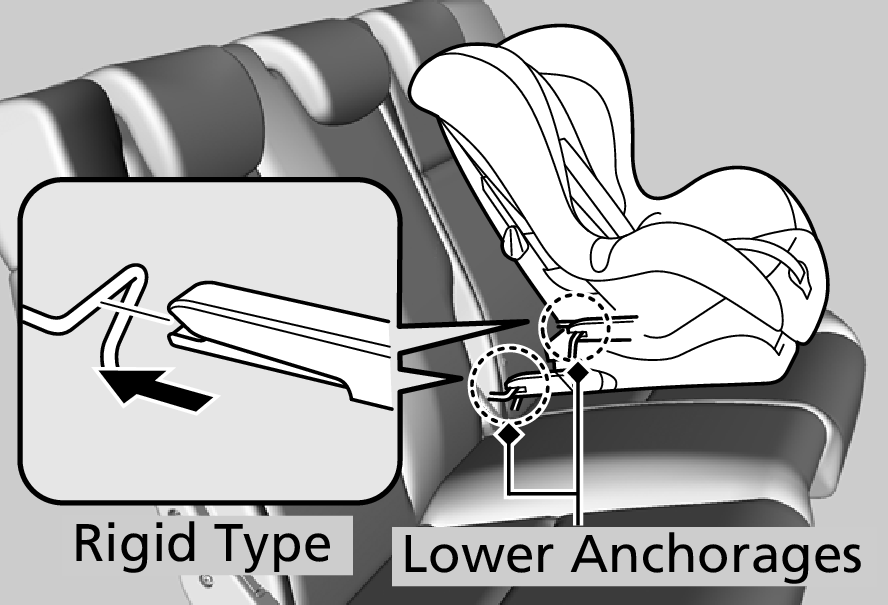
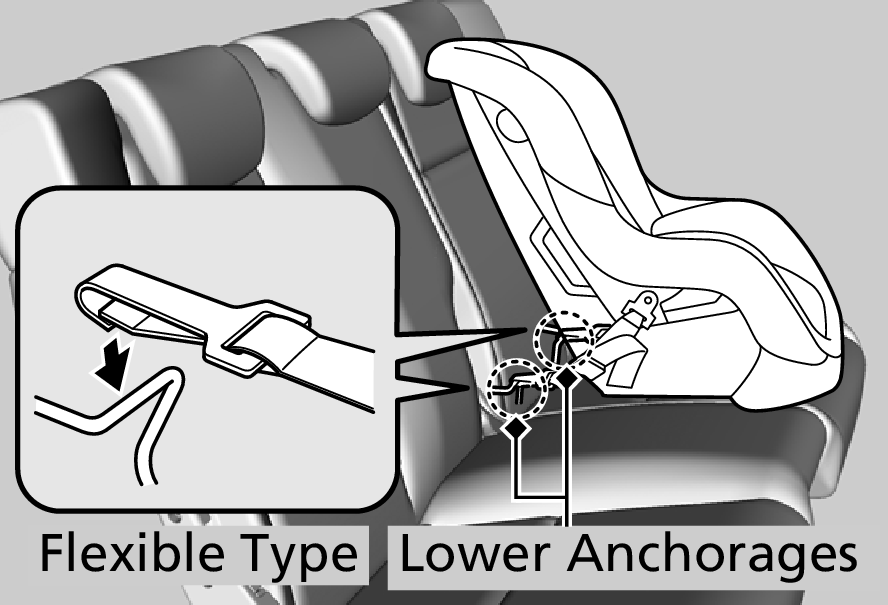
-
- Open the anchorage cover.
- Route the tether strap over the seat-back. Make sure the strap is not twisted.
- Secure the tether strap hook onto the anchorage.
- Tighten the tether strap as instructed by the child restraint system manufacturer.
-
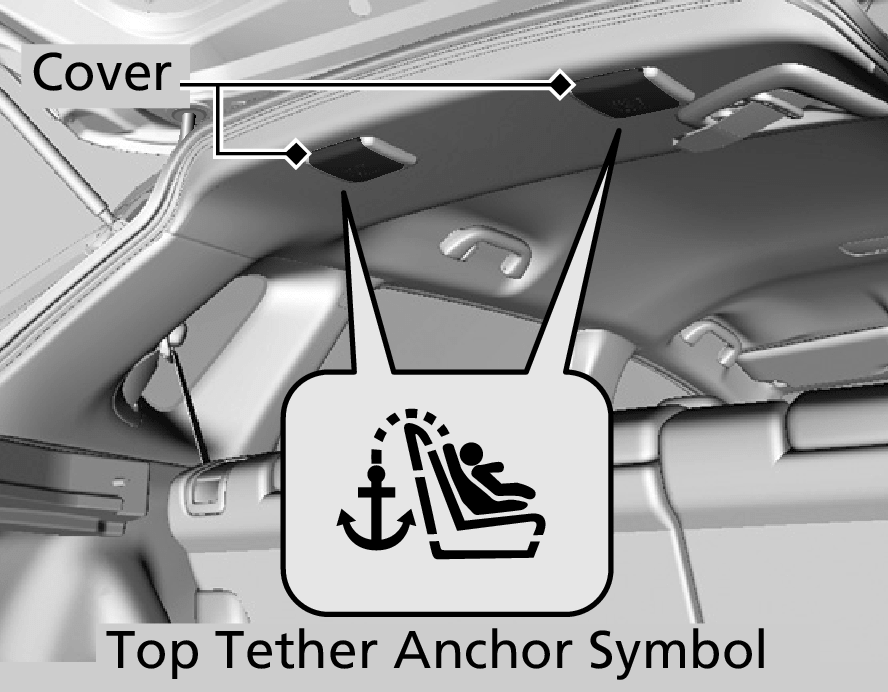
-
- Make sure the child restraint system is firmly secured by rocking it forward and back and side to side; little movement should be felt.
- Make sure any unused seat belt that a child can reach is buckled, the lockable retractor* is activated, and the belt is fully retracted and locked.
-
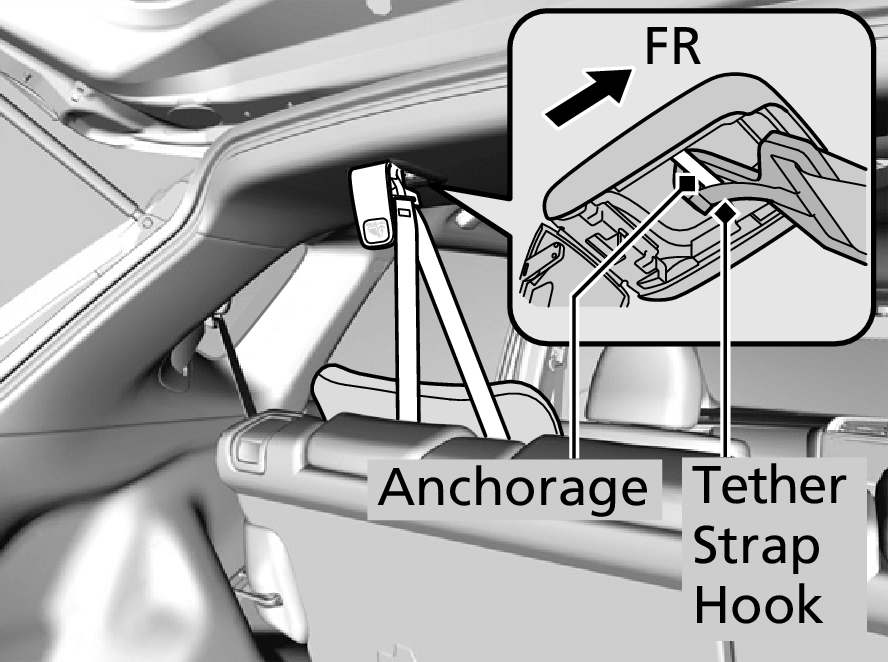
- Detail
-
Some child restraint systems come with optional guide-cups, which avoid possible damage to the seat surface. Follow the manufacturer’s instructions when using the guide-cups, and attach them to the lower anchorages as shown in the image.
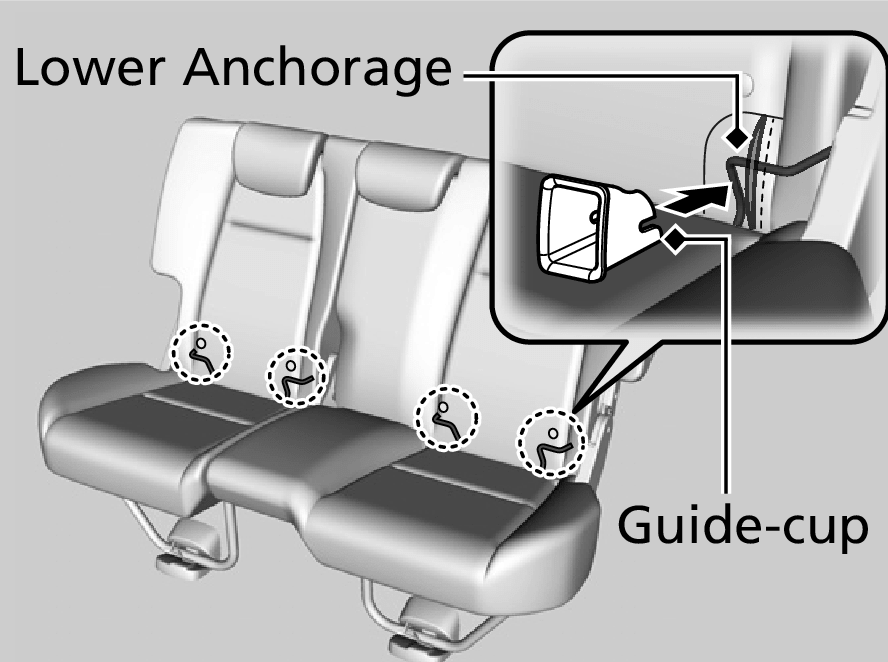 For your child's safety, when using a child restraint system installed using the lower anchorage system, make sure that the restraint system is properly secured to the vehicle. A child restraint system that is not properly secured will not adequately protect a child in a crash and may cause injury to the child or other vehicle occupants.The flexible type may not be available in your country.
For your child's safety, when using a child restraint system installed using the lower anchorage system, make sure that the restraint system is properly secured to the vehicle. A child restraint system that is not properly secured will not adequately protect a child in a crash and may cause injury to the child or other vehicle occupants.The flexible type may not be available in your country.
WARNING: Never use a hook that does not come with a Top Tether anchor symbol when securing an installed child restraint system.
Installing a Child Restraint System with a Lap/Shoulder Seat Belt
-
- Make sure to lock the seat-back in the upright position.
- Lower the head restraint to its lowest position.
- Place the child restraint system on the vehicle seat.
- Route the seat belt through the child restraint system according to the child restraint system manufacturer's instructions, and insert the latch plate into the buckle.
- Insert the latch plate fully until it clicks.
-
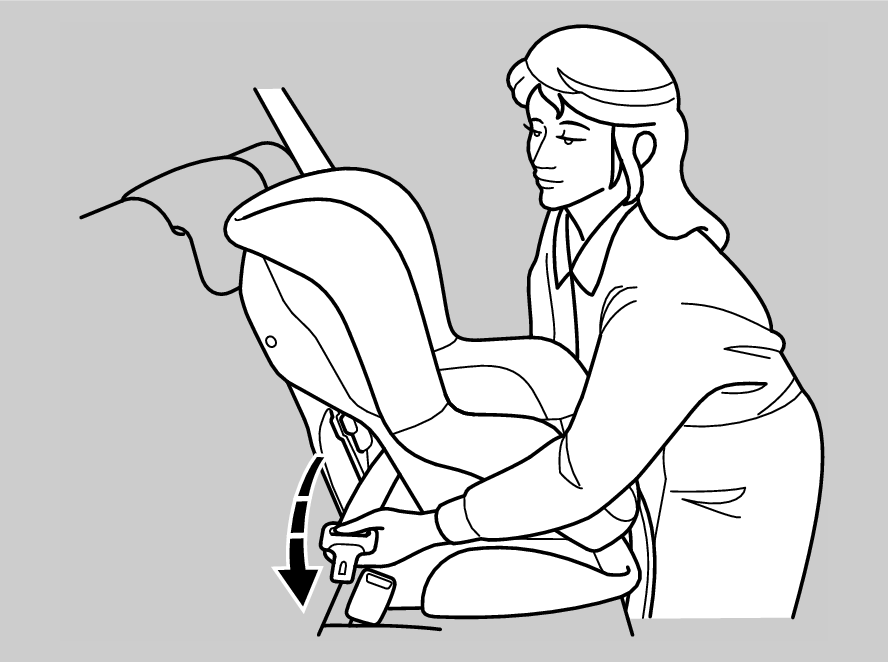
-
Lap/shoulder seat belt with lockable retractor
- Slowly pull the shoulder part of the belt all the way out until it stops. This activates the lockable retractor.
- Push down the tab. Route the shoulder part of the belt into the slit at the side of the restraint.
-
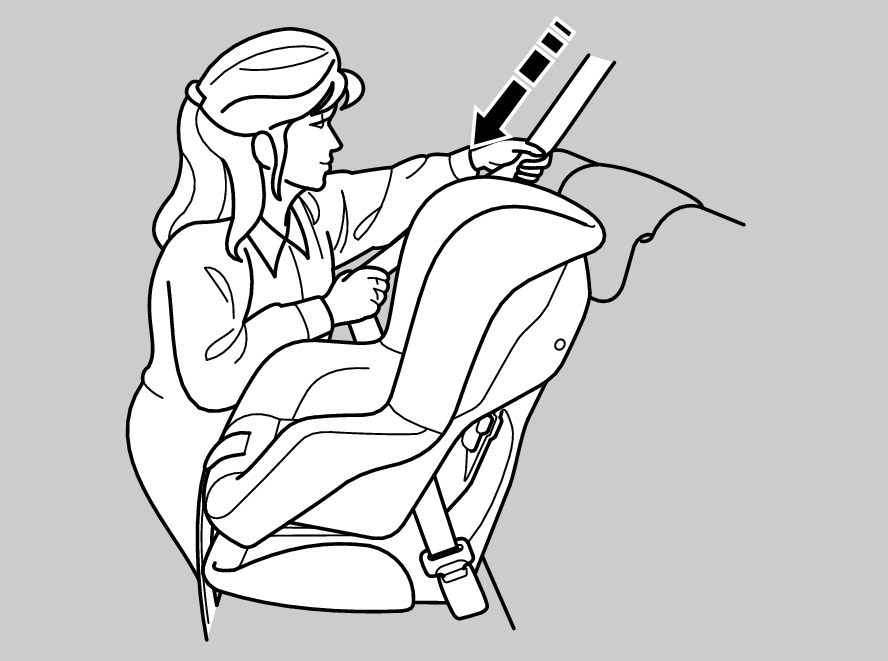
-
- Let the seat belt completely wind up into the retractor, then try to pull it out to make sure the retractor is locked.
- If you are able to pull the shoulder belt out, the lockable retractor is not activated. Pull the seat belt all the way out, and repeat steps 4 – 6.
- Let the seat belt completely wind up into the retractor, then try to pull it out to make sure the retractor is locked.
-
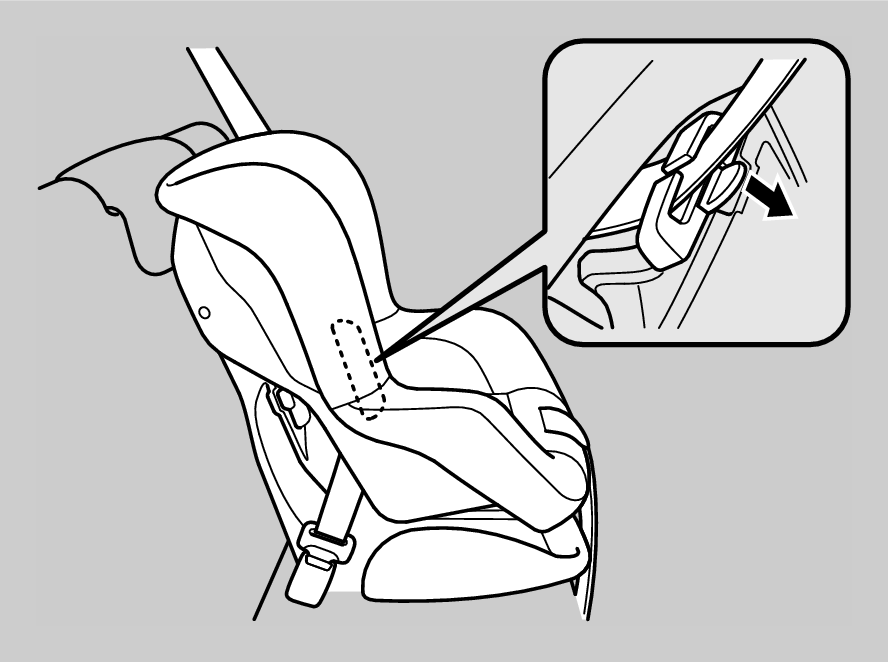
-
- Grab the shoulder part of the seat belt near the buckle, and pull up to remove any slack from the lap part of the belt.
- When doing this, place your weight on the child restraint system and push it into the vehicle seat.
- Position the belt properly. Make sure the belt is not twisted.
- While pulling down the tab, pull up the upper shoulder part of the belt to remove any slack from the belt.
- Grab the shoulder part of the seat belt near the buckle, and pull up to remove any slack from the lap part of the belt.
-
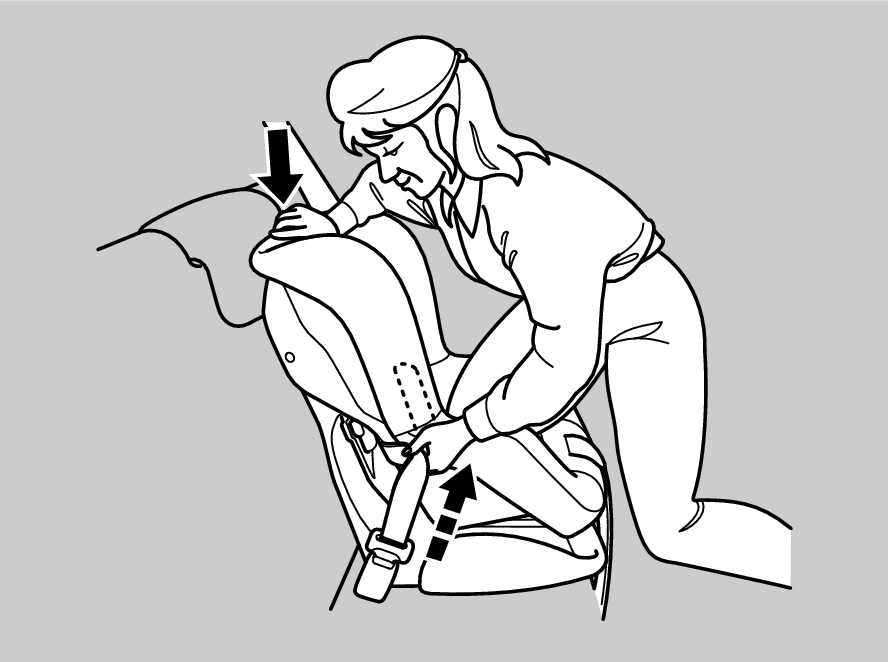
-
Lap/shoulder seat belt without lockable retractor
- Push down the tab. Route the shoulder part of the belt into the slit at the side of the restraint.
- Grab the shoulder part of the belt near the buckle, and pull up to remove any slack from the lap part of the belt.
- When doing this, place your weight on child restraint system and push it into the vehicle seat.
- Position the belt properly. Make sure the belt is not twisted.
- While pulling down the tab, pull up the upper shoulder part of the belt to remove any slack from the belt.
- Go to step 10.
-
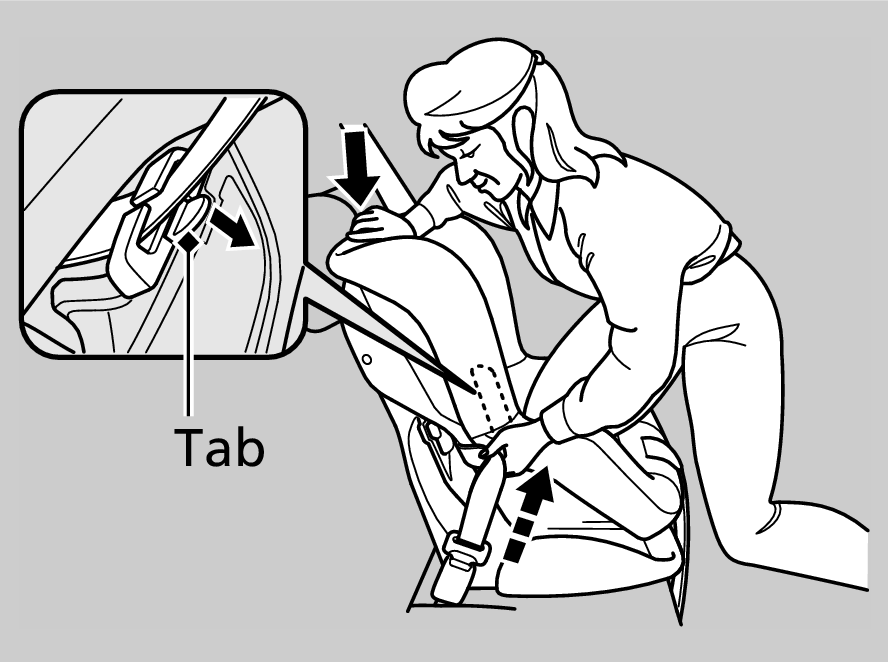
-
All models
- Make sure the child restraint system is firmly secured by rocking it forward and back and side to side; little movement should be felt.
- Make sure any unused seat belt that a child can reach is buckled.
-
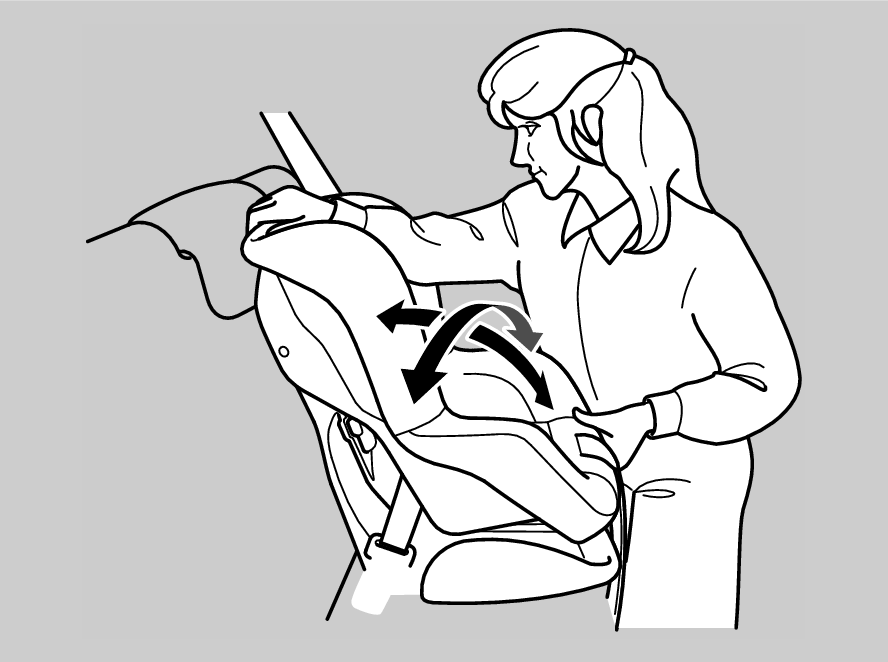
-
Lap/shoulder seat belt without lockable retractorIf your child restraint system does not come with a mechanism that secures the belt, install a locking clip on the seat belt.After going through the step 1 to 4, pull up the shoulder part of the belt and make sure there is no slack in the lap portion.
- Tightly grasp the belt near the latch plate. Pinch both parts of the belt together so they do not slip through the latch plate. Unbuckle the seat belt.
- Install the locking clip as shown in the image. Position the clip as close as possible to the latch plate.
- Insert the latch plate into the buckle. Go to step 9 and 10.
-
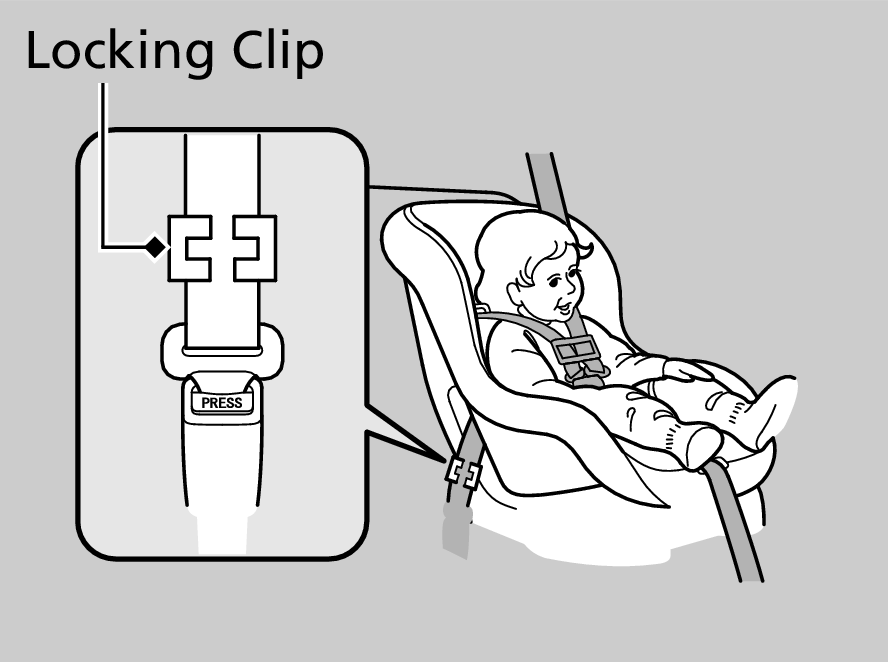
- Detail
-
To check if the lap/shoulder belt is equipped with the lockable retractor, pull the lap part of the lap/ shoulder belt all the way out, let the belt retract slowly, then pull the belt again gently. If the belt is locked, the belt is equipped with the lockable retractor.The seat belt with a lockable retractor has a label as shown in the image.
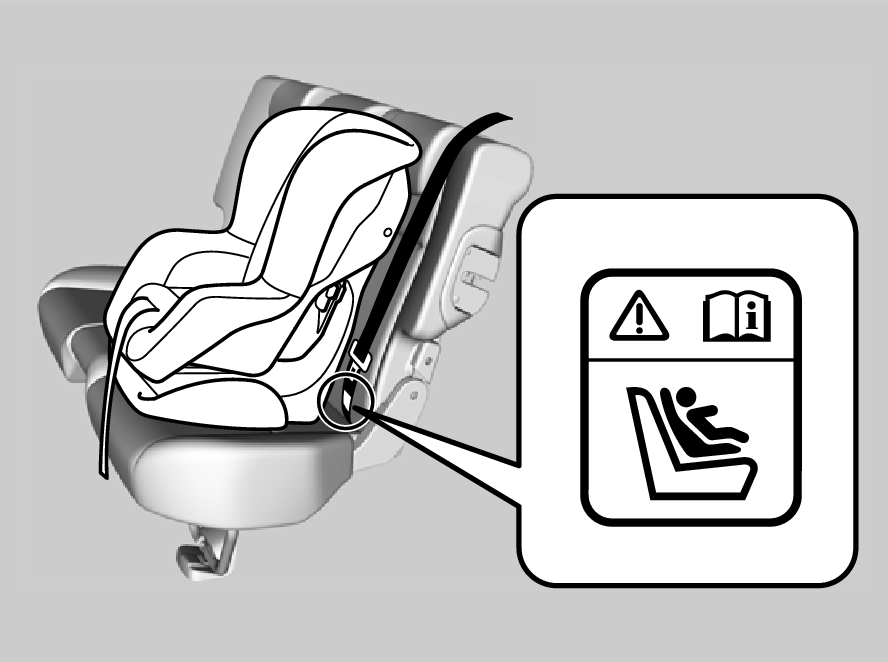 A child restraint system that is not properly secured will not adequately protect a child in a crash and may cause injury to the child or other vehicle occupants.Lap/shoulder seat belt with lockable retractorAfter the child restraint system is installed properly, check if the lockable retractor is activated and the belt is fully retracted and locked. To deactivate a lockable retractor, release the buckle and allow the seat belt to wind up all the way.
A child restraint system that is not properly secured will not adequately protect a child in a crash and may cause injury to the child or other vehicle occupants.Lap/shoulder seat belt with lockable retractorAfter the child restraint system is installed properly, check if the lockable retractor is activated and the belt is fully retracted and locked. To deactivate a lockable retractor, release the buckle and allow the seat belt to wind up all the way.
Installing a Child Restraint System with a Lap Belt*
-
- Place the child restraint system on the vehicle seat.
- Move the adjustable second row seat * to its rearmost position, and make sure to lock the seat-back in the upright position.
- Route the seat belt through the child restraint system according to the seat maker’s instructions, and insert the latch plate into the buckle.
- Insert the latch plate fully until it clicks.
- Pull hard on the loose end of the belt to remove any slack.
- When doing this, place your weight on the child restraint system and push it into the vehicle seat.
- Make sure the child restraint system is firmly secured by rocking it forward and back and side to side; little movement should be felt.
-
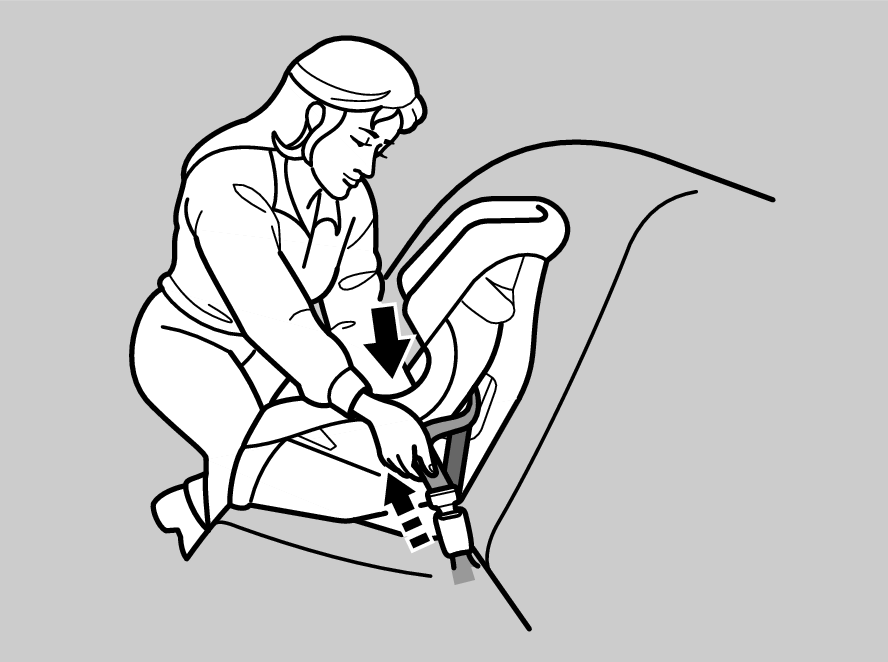
Adding Security with a Tether*
- Two tether anchorage points are provided on the ceiling for rear outer seating positions. A child restraint system that is installed with a seat belt and comes with a tether can use the tether for additional security.
- Locate the appropriate tether anchorage point.
- Lower the head restraint to its lowest position.
-
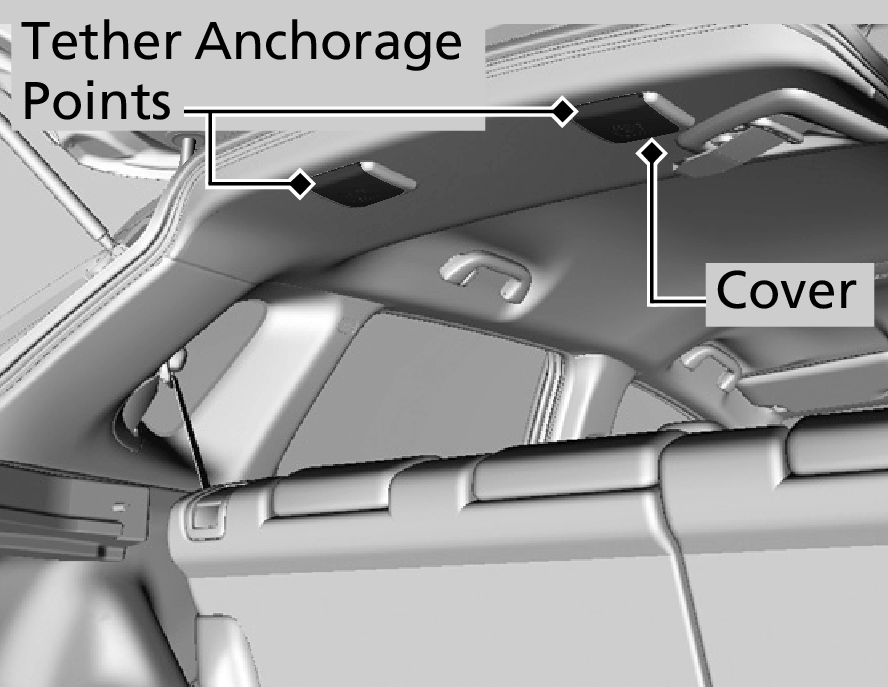
-
- Open the anchorage cover.
- Route the tether strap over the seat-back. Make sure the strap is not twisted.
- Secure the tether strap hook onto the anchorage.
- Tighten the tether strap as instructed by the child restraint system manufacturer.
-

- Detail
-
WARNING: Child restraint anchorages are designed to withstand only those loads imposed by correctly fitted child restraints. Under no circumstances are they to be used for adult seat belts, harnesses or for attaching other items or equipment to the vehicle.Since a tether can provide additional security to the lap/shoulder seat belt installation, we recommend using a tether whenever one is available.
* Not available on all models
- Recommend page
